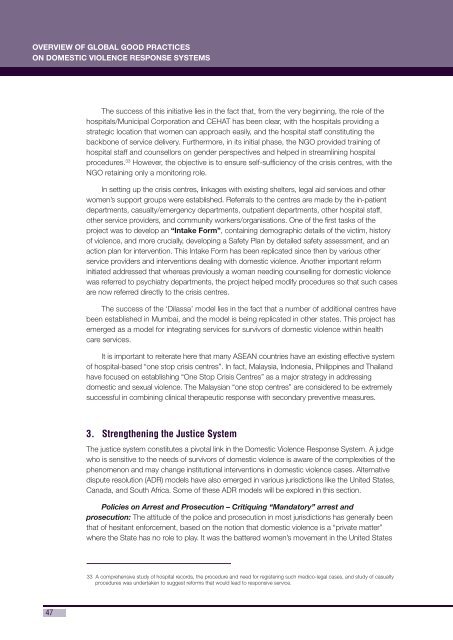Domestic Violence Legislation and its Implementation
Domestic Violence Legislation and its Implementation
Domestic Violence Legislation and its Implementation
You also want an ePaper? Increase the reach of your titles
YUMPU automatically turns print PDFs into web optimized ePapers that Google loves.
OVERVIEW OF GLOBAL GOOD PRACTICES<br />
ON DOMESTIC VIOLENCE RESPONSE SYSTEMS<br />
47<br />
The success of this initiative lies in the fact that, from the very beginning, the role of the<br />
hospitals/Municipal Corporation <strong>and</strong> CEHAT has been clear, with the hospitals providing a<br />
strategic location that women can approach easily, <strong>and</strong> the hospital staff constituting the<br />
backbone of service delivery. Furthermore, in <strong>its</strong> initial phase, the NGO provided training of<br />
hospital staff <strong>and</strong> counsellors on gender perspectives <strong>and</strong> helped in streamlining hospital<br />
procedures. 33 However, the objective is to ensure self-suffi ciency of the crisis centres, with the<br />
NGO retaining only a monitoring role.<br />
In setting up the crisis centres, linkages with existing shelters, legal aid services <strong>and</strong> other<br />
women’s support groups were established. Referrals to the centres are made by the in-patient<br />
departments, casualty/emergency departments, outpatient departments, other hospital staff,<br />
other service providers, <strong>and</strong> community workers/organisations. One of the fi rst tasks of the<br />
project was to develop an “Intake Form”, containing demographic details of the victim, history<br />
of violence, <strong>and</strong> more crucially, developing a Safety Plan by detailed safety assessment, <strong>and</strong> an<br />
action plan for intervention. This Intake Form has been replicated since then by various other<br />
service providers <strong>and</strong> interventions dealing with domestic violence. Another important reform<br />
initiated addressed that whereas previously a woman needing counselling for domestic violence<br />
was referred to psychiatry departments, the project helped modify procedures so that such cases<br />
are now referred directly to the crisis centres.<br />
The success of the ‘Dilassa’ model lies in the fact that a number of additional centres have<br />
been established in Mumbai, <strong>and</strong> the model is being replicated in other states. This project has<br />
emerged as a model for integrating services for survivors of domestic violence within health<br />
care services.<br />
It is important to reiterate here that many ASEAN countries have an existing effective system<br />
of hospital-based “one stop crisis centres”. In fact, Malaysia, Indonesia, Philippines <strong>and</strong> Thail<strong>and</strong><br />
have focused on establishing “One Stop Crisis Centres” as a major strategy in addressing<br />
domestic <strong>and</strong> sexual violence. The Malaysian “one stop centres” are considered to be extremely<br />
successful in combining clinical therapeutic response with secondary preventive measures.<br />
3. Strengthening the Justice System<br />
The justice system constitutes a pivotal link in the <strong>Domestic</strong> <strong>Violence</strong> Response System. A judge<br />
who is sensitive to the needs of survivors of domestic violence is aware of the complexities of the<br />
phenomenon <strong>and</strong> may change institutional interventions in domestic violence cases. Alternative<br />
dispute resolution (ADR) models have also emerged in various jurisdictions like the United States,<br />
Canada, <strong>and</strong> South Africa. Some of these ADR models will be explored in this section.<br />
Policies on Arrest <strong>and</strong> Prosecution – Critiquing “M<strong>and</strong>atory” arrest <strong>and</strong><br />
prosecution: The attitude of the police <strong>and</strong> prosecution in most jurisdictions has generally been<br />
that of hesitant enforcement, based on the notion that domestic violence is a “private matter”<br />
where the State has no role to play. It was the battered women’s movement in the United States<br />
33 A comprehensive study of hospital records, the procedure <strong>and</strong> need for registering such medico-legal cases, <strong>and</strong> study of casualty<br />
procedures was undertaken to suggest reforms that would lead to responsive service.

















